NYC’s Forgotten ‘War on Christmas Trees’
Discover how an obscure holiday crackdown affects festive street vendors today!



As we usher in 2022, public art installations continue to open across New York City. From Flushing Meadows-Corona Park to Roosevelt Island, the city has countless new public art installations to enjoy. To start 2022 off with a bang, be sure to check out Hana Yilma Godine’s painting exhibition A Hair Salon in Addis Ababa, the large-scale crochet flower mural Stand-Speak-Shape in Columbus Park, and Sherwin Banfield’s statue honoring the legacy of American rapper LL Cool J. In addition, read on to learn more about art installations still up from previous months.
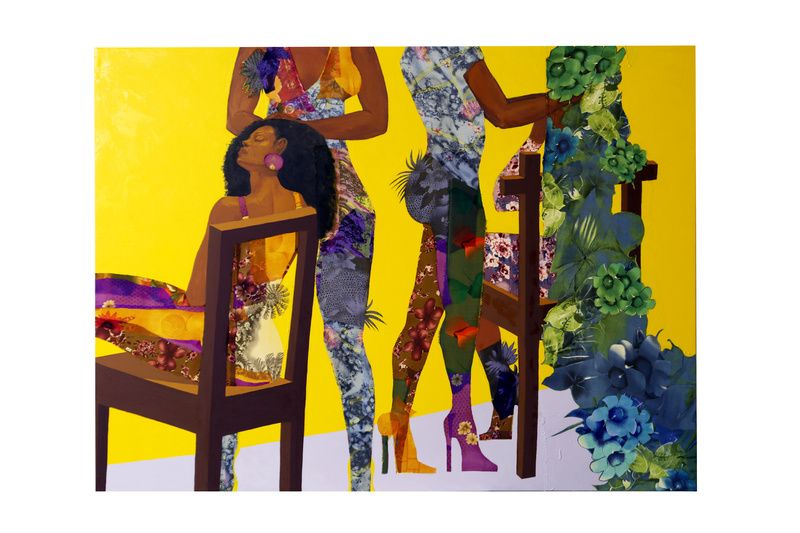
Beginning on January 19, 2022, both the Fridman and Rachel Uffner Galleries will present the solo exhibition A Hair Salon in Addis Ababa by Ethiopian painter Hana Yilma Godine. Each gallery will present Godine’s new paintings which portray female protagonists in domestic and public spaces of their own making, drawing on everyday scenes from the artist’s hometown of Addis Ababa. Example paintings depict scenes such as wedding preparations, living rooms, and travels to the hair salon. In doing so, Godine works to present a parallel dimension to the current patriarchal and war-torn Ethiopian society where women are safe from violence and capable of freely expressing themselves.
A Hair Salon in Addis Ababa draws from traditional Ethiopian iconography. Godine’s paintings often employ a flattened perspective, elongated figures, and evenly distributed light to draw reference to the divinity of biblical subjects. At the same time, Godine’s work is grounded in reality, painting on traditional fabrics bought by women at the local market and used to make clothing. Ultimately, this juxtaposition of fiction and reality gives A Hair Salon in Addis Ababa the appearance of traveling through time, offering a futuristic worldview based on spirit, community, care, and hope. The exhibition will be on display through March 5, 2022.

Stand-Speak-Shape is a large-scale crochet mural by the Chinatown Yarn Circle Project in collaboration with Think Chinatown, the Creative Sanctum, and artist Naomi Lawrence. On display until October 8, 2022, the mural ushers in words of strength, synergy, and solidarity to culturally inspire Chinatown residents to stand strong together, speak up for justice, and shape society through sharing community life together. In addition, the mural serves as a tribute to AAPI community builders and a means of bringing awareness to issues facing members of the community.
Featuring nearly 1,000 crochet squares, over 1,000 leaves, and 1,500 flowers sewn together into a 4-foot-high by 25-foot-wide mural, Stand-Speak-Shape adorns the fences of Columbus Park. Crocheted by neighborhood volunteers, the mural’s flowers serve as symbolic ties to the Asian community at large. Example flowers in the mural include Plum Blossoms for Taiwan, Chrysanthemum for Japan, Arabian Jasmine for the Philippines, and Hibiscus for Malaysia among others.
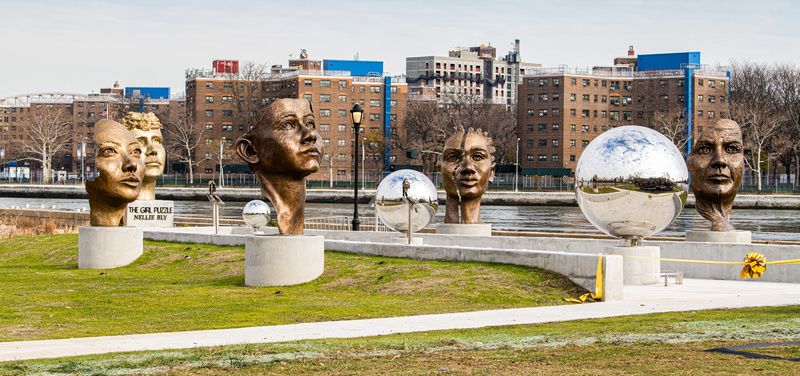
Located on Roosevelt Island is The Girl Puzzle, a monument installation by artist Amanda Matthews paying tribute to Nellie Bly. Over the course of her life, Bly worked as a journalist, women’s rights activist, suffragist, World War II correspondent, inventor/patent holder, industrialist, and humanitarian. Above all else, she strived to write stories exposing the struggles of marginalized individuals like herself and pushed for equality and progress, especially for women. In particular, The Girl Puzzle was inspired by Bly’s 1885 response to bigotry and her 1887 seminal work, Ten Days in a Mad-House, in which she exposed the deplorable living conditions she witnessed at the Blackwell Island Asylum on Roosevelt Island, which she gained access to by feigning insanity.
To highlight Bly’s legacy, The Girl Puzzle presents the faces of other women who have endured hardship in their lives and were made stronger because of it. In the center of the monument are a bust of Bly’s face cast in silver bronze and three silver globes representing her journalism career. Surrounding Bly’s face and the silver globes are four additional busts cast in bronze representing Asian American, Black, young, older, and queer women, each rendered in partial sections to appear like giant puzzle pieces. The faces express the deep emotion of being both broken and repaired and allow for the audience to interact with the reflective surfaces and imagine the different parts of the face coming together. In addition, Bly’s words are engraved behind each woman, representing the spirit and complexity of women and the stories they have to tell.
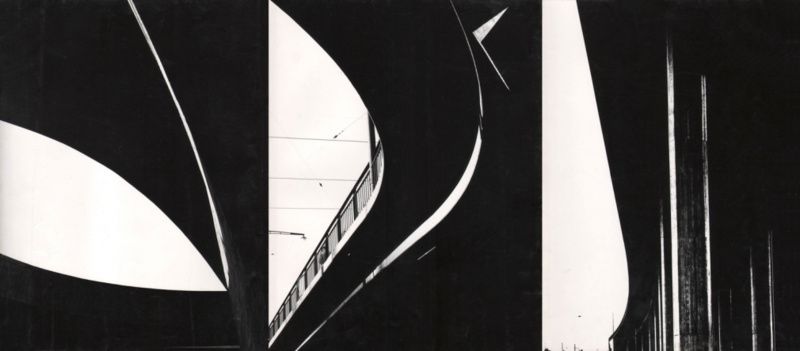
This winter, the Keith de Lellis Gallery will present Swedish Modern: Mid Century Photographs by Swedish Photographers, a selection of 13 accomplished mid-century Swedish photographers whose innovative work remains relatively unfamiliar to American audiences. Eight of the featured photographers include members of the TIO — a famous collective of Swedish photographers established in 1958 — such as Sten Didrik Bellander, Hans Hammarskiöld, Sven Gillsäter, and Georg Oddner. One standout piece within the exhibition is Lennart Olson’s 1960 triptych Project for a Mural, which abstracts the industrial rigidity of modern bridges through the usage of deep contrast.
Photography work from TIO’s founding members was originally shown in the United States at the Library of Congress in 1971. Swedish Modern will mark the first American group showcase of work from TIO members in 50 years. From nature and industrial scenes to abstraction and fashion, Swedish Modern highlights the broad range of interests present for mid-century Swedish photographers. Uniting the disparate photographs in the exhibition is their shared attitude of inquiry into the possibilities of what the camera is capable of capturing and the varying emotions that can be expressed to audiences. Swedish Modern: Mid Century Photographs by Swedish Photographers will be open through March 11, 2022.

Located at Flushing Meadows-Corona Park in the David Dinkins Circle is Going Back to the Meadows, A Tribute to LL Cool J and Performance at F.M.C.P — also labeled as The G.O.A.T. Monument — a statue honoring American rapper LL Cool J. Support for the statue was provided through the NYC Art in the Parks: Alliance for FMCP Grant, Queens Council on the Arts, and City Artist Corps Grant.
Created by artist Sherwin Banfield, The G.O.A.T. Monument features a representation of a younger LL Cool J wearing a Kangol hat and holding a gold boombox. Sitting inside the box is a cassette of “Radio,” the musician’s first record. The statue comes on the heels of LL Cool J’s induction into the Rock & Roll Hall of Fame, which took place on October 30, 2021. Going Back to the Meadows, A Tribute to LL Cool J and Performance at F.M.C.P will be on display until November 2022.
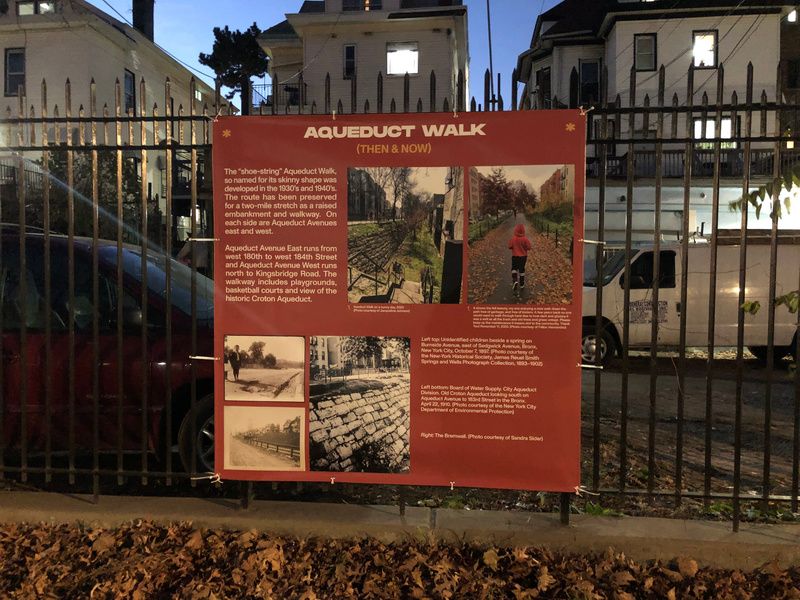
Through March 4, 2022, the public exhibition Coming Full Circle, Visions and Practices of Resilience by the Friends of the Old Croton Aqueduct and Community Heroes will be on view at West 183rd Street and Aqueduct Avenue in the Bronx. Coming Full Circle, Visions and Practices of Resilience highlights the history of the Aqueduct Walk, connecting its role in public health during the city’s cholera epidemic to the current community’s resilience during the COVID-19 pandemic.
The exhibition features family photos and memories collected from community members through email and in-person scanning events. Displayed alongside these photos are oral history interviews with longtime community members and historical photos of the area — collected in partnership with the Bronx Community College Archives. Curated by Jacqueline Johnson-Carmichael, support for the exhibition was also provided by Photoville and Partnerships for Parks.

On view until January 31, 2022, is the art exhibition Members Only, featuring over 75 works of art created by 15 visual artists. Curated by Connie Lee, the work on display covers a plethora of mediums, sizes, and price ranges. In addition, many pieces offer visual commentary on current social and political issues such as Barbara Lubliner’s Flower Lips which was created in response to recent Supreme Court discussions on reproductive rights.
Featured artists in Members Only include Capucine Bourcart, Pauline Galiana, Elizabeth Riley, and Susan Stair. For the exhibition, mixed-media artist Giannina Gutierrez created an entire wall of drawings while Stair crafted LA Burning, interspersing dark tree bark with fire-red glass mosaic pieces to reflect on the raging wildfires across the Pacific Northwest. Members Only can be found inside the salon at Living with Art which is located in the historic Mount Morris Park District of Harlem at 17 West 121st Street #3.
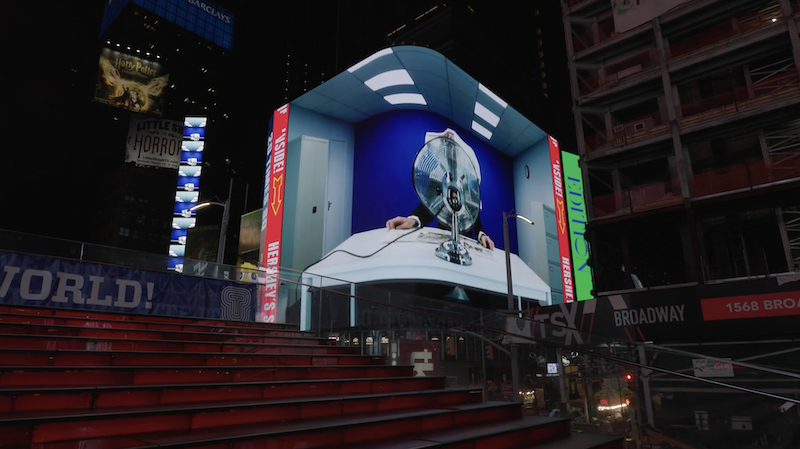
In January, Times Square Arts will present Building Things by artist duo Wood & Harrison, consisting of British artists John Wood and Paul Harrison. The tragi-comic film will be part of the Times Square Arts Midnight Moment series, airing across 80 electronic billboards throughout Times Square from 11:57 p.m. to 12:00 a.m. every day.
Building Things features a series of vignettes that follow the descent of a camera down the side of a fictitious office building, offering glimpses into room after room where various scenes unfold. Ranging from the mundane to the absurd, each floor represents a typical office space, with the actions of every worker becoming increasingly non-administrative as the film progresses. Co-presented with the Cristin Tierney Gallery, Building Things pokes fun at the conventions of the office space and the routines of the workday, a particularly poignant topic as workers begin returning to their offices after months away.
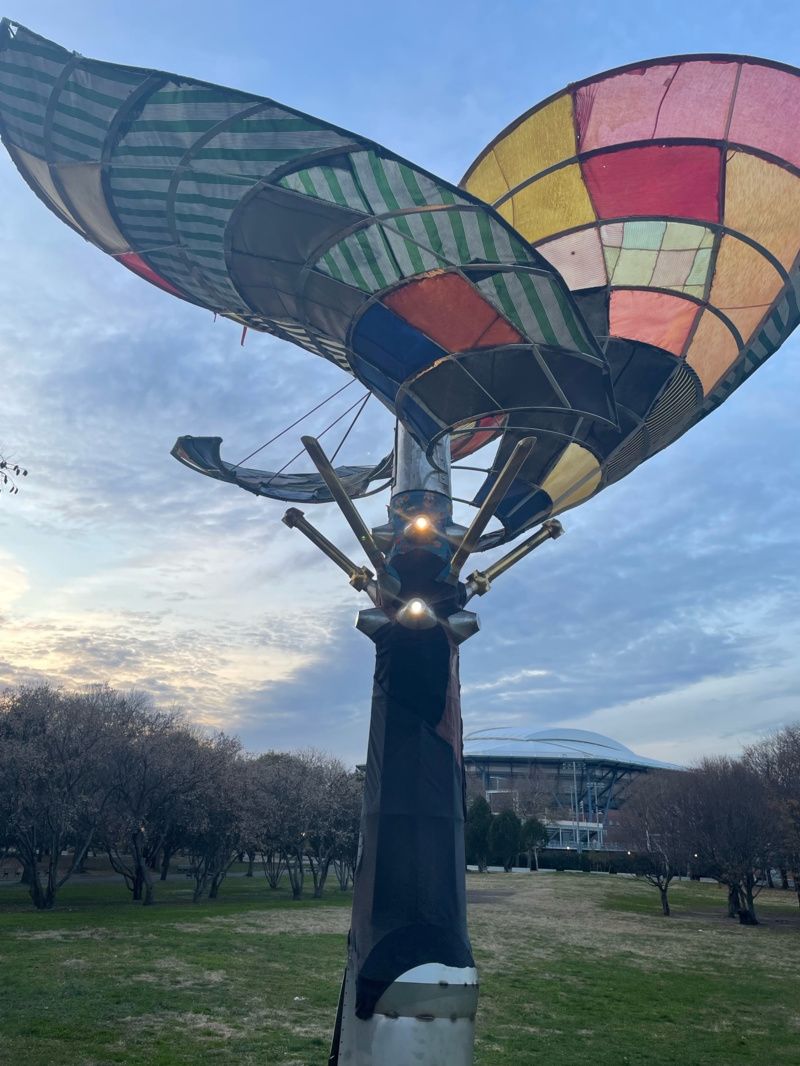
Through November 23, 2022, Haksul Lee’s sculpture, The Giving Tree will be on display in Flushing Meadows-Corona Park. The sculpture works to bring awareness to the environmental concerns of the Queens community. It was created thanks to support from the Art in the Parks: Alliance for Flushing Meadows Corona Park Grant, which provides funding for site-specific public art installations in two locations at the park.
Using wind power to generate electricity, the artificial tree will light the park and provide a charger station for visitors. In addition, The Giving Tree serves as a form of altruism promoting a higher level of collective consciousness to push New Yorkers towards acknowledging and addressing the climate issues that currently affect the city and issues that stand to arise in the future.
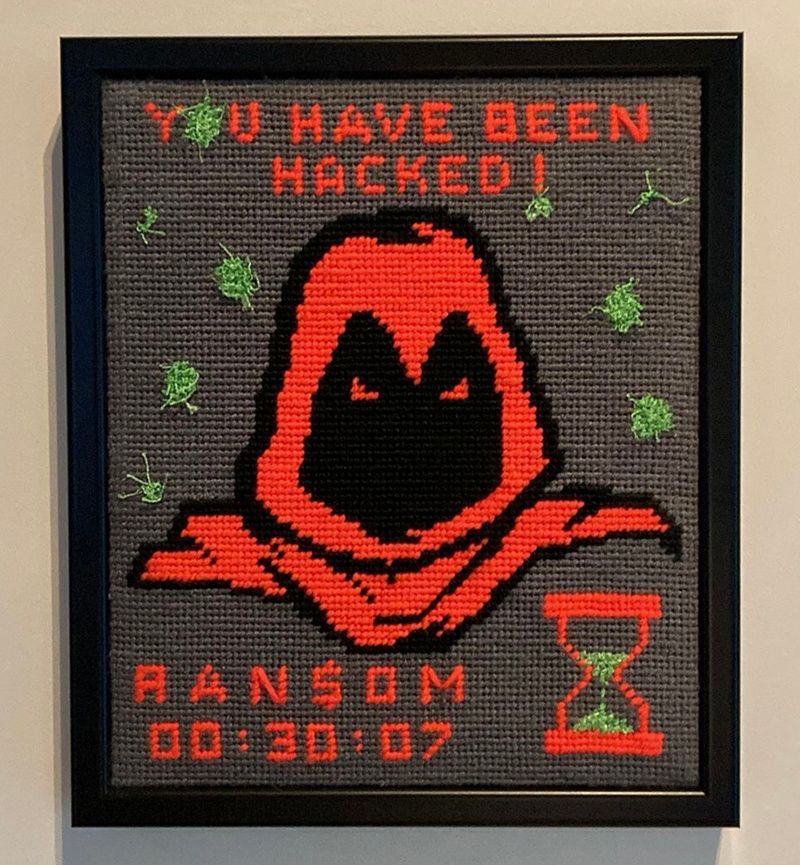
Located inside the Port Authority south building is artist Kevin Lustik’s needlepoint installation In Stitches. Lustik began his career as a quilter before moving on to original needlepoint and cross-stitch designs.
Filling two large glass cases, In Stitches incorporates beads, buttons, thread, yarn, and needles to create various 3-D art pieces reflecting on the artist’s unique sense of humor. Prime examples from the installation include a 3D yellow and black cliff notes book for Shakespeare’s Hamlet made entirely from yarn and a stitched illustration of a parking meter whose time has expired. In Stitches can be viewed through January 2022.
Continue reading to see what is still on display from previous months in NYC!
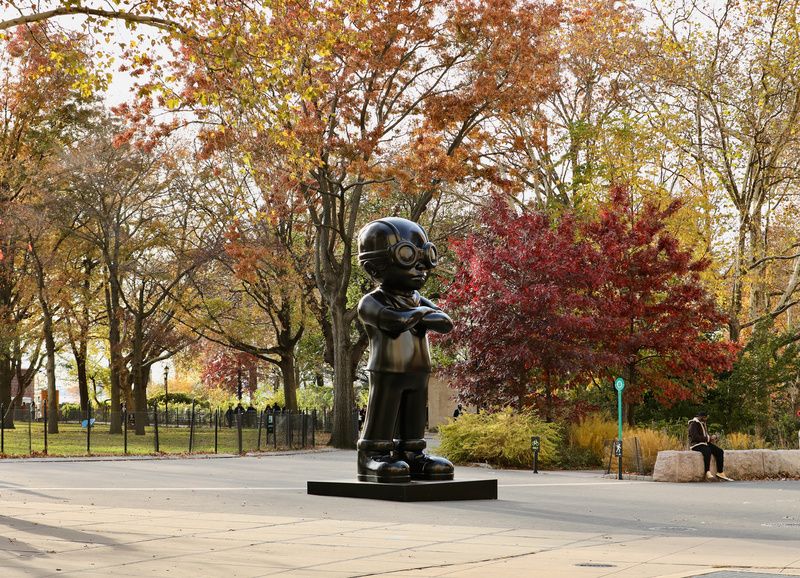
On display at The Battery in Lower Manhattan is artist Hebru Brantley’s 16-foot steel sculpture The Great Debate, depicting Flyboy — a superhero character of color created by Brantley in response to the few characters of color found within the comic book world. Brantley was inspired by the Tuskegee Airmen, the first African-American military aviator pilots who fought in World War II. Flyboy serves as a nod of admiration towards these men, aimed at inspiring future generations to soar above their predicted possibilities, regardless of the challenges standing in their way. Presented in partnership with NYC Parks’ Art in the Parks program, The Great Debate forces its audience to reflect on the meaning of freedom in American society today. The Great Debate will be available for view through November 13, 2022.
For Brantley: “The Great Debate is a piece that is personal and important to me – it features Flyboy in a stance that represents confident optimism. My hope is that The Great Debate at The Battery will serve as a consistent reminder to hold your head high, stand firm in what you believe in, and keep pushing forward with confidence.”
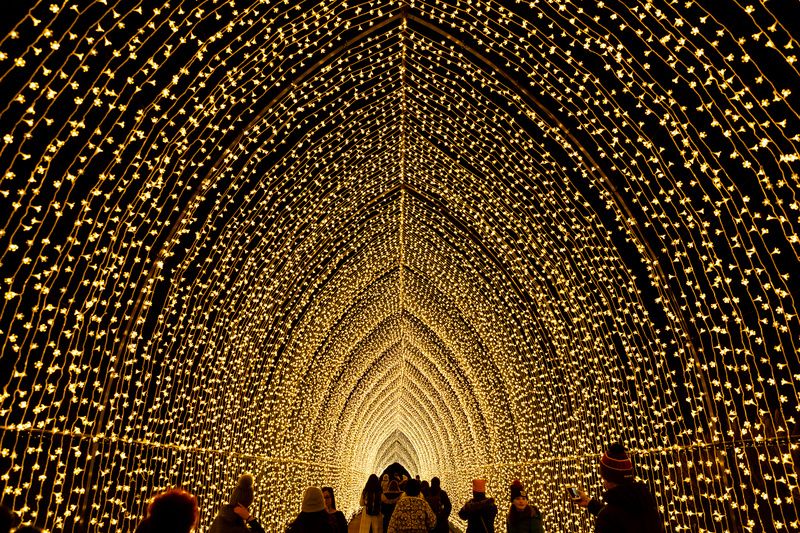
Through January 9, 2022, the Brooklyn Botanic Garden (BBG) will host Lightscape, an after-dark illuminated spectacular celebrating the beauty of winter. The exhibition will feature a festive trail winding through the garden’s 52-acre landscape complete with colorful light displays highlighting the trees, landscape, and architecture and site-specific music and sounds. More than 18 works of art will be on display and will be animated with over one million lights. One standout display will be the Mandylights’ Winter Cathedral, a 100-foot tunnel adorned with thousands of LED lights in the shape of a traditional Gothic arch. Covering the Cherry Esplanade will be the animated light show Sea of Life by Ithaca. Other attractions will include Ashley Bertling’s Fire Garden, which uses bespoke structures to fill the garden with real fire from candles, accompanied by seasonal music, and Frog Man’s Laser Pond, which involves laser beams being shot across the water in the Japanese-Hill-and-Pond Garden to the sound of music.
Lightscape will also directly highlight the work of local artists including Jacqueline Woodson’s site-specific poems, collectively known as Remember the Light Inside You, which will be projected onto trees, shrubs, and hillocks near Bluebell Wood. Through this series of poems, Woodson aims to engage visitors’ senses and immerse them fully into the beauty of nature, even during one of the darkest times of the year. For nonmembers of the Brooklyn Botanic Garden, tickets are priced at $34 for adults and $18 for children ages 3-12. BBG member admission tickets are $30 for adults and $16 for children.
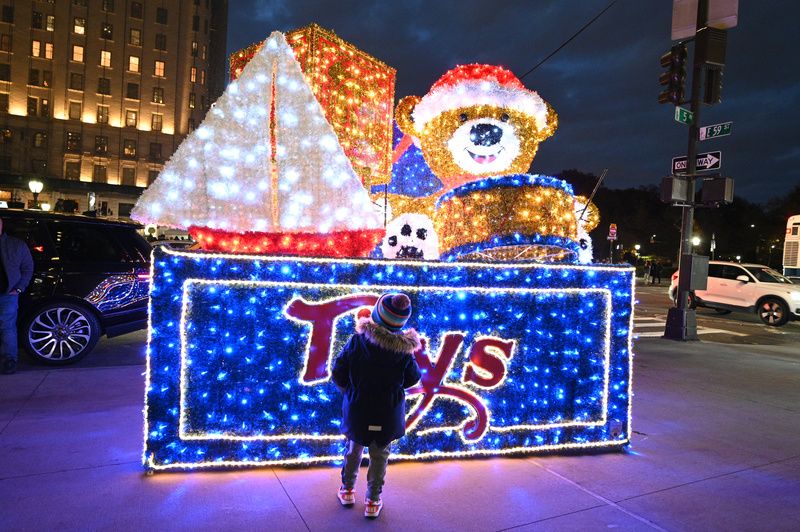
Located along Manhattan’s Fifth Avenue is The Fifth Season, a series of 32 hand-crafted-in-Brooklyn animal sculptures across from the Plaza Hotel, 5,000 feet of lighting, a skating rink, and 24 handmade icebergs surrounding the Pulitzer Fountain. The installation is accompanied by music from composer Paul Brill, with all elements created by artisans of Harlequin Designs.
The Fifth Season builds on last year’s Make it Bright showcase, which featured oversized lit toys including a teddy bear, dreidel, and red truck displayed on Fifth Avenue from 47th to 60th Streets. With Fifth Avenue’s reputation as one of the most globally renowned spots for partaking in winter festivities, The Fifth Season serves as a celebration of the holiday decor, music, and traditions that make the holidays one of the most magical times of the year.

Artist Cecile Chong’s installation EL DORADO – The New Forty Niners pays tribute to the 49% of New York households that speak a language other than English. The installation features 100 colored “guagua” sculptures meant to represent a community of people from around the world, with 49 being painted in gold. Each sculpture varies in height from 8 to 24 inches tall. Chong derived the title for the installation from a story taught to her while growing up in Ecuador, with “El Dorado” meaning “the golden.”
Since 2017, EL DORADO – The New Forty Niners has been displayed in every borough of the city. Currently, it is in its fifth and final iteration at the Dag Hammarskjöld Plaza at 47th Street and 2nd Avenue through August 30, 2022. For this version of the installation, the sculptures have been arranged on 17 colored planks to represent the 17 UN sustainability goals which seek to bring developed and developing countries together in a global partnership to reduce inequality and spur economic growth.

At Prospect Park is Rose DeSiano’s Lenticular Histories, an immersive and interactive monument that aims to celebrate acts of “leisure and activism.” Using reflections, refractions, and nonlinear photo-history, Lenticular Histories takes viewers on a journey through the historical narrative of Prospect Park. To do so, the installation incorporates historical photographs from private collections, public archives, and New York journalists. In addition, the installation uses three objects of optical illusions — stereoscopes, lenticulars, and prisms — to blend reflections, rainbow-colored lights, and history into one singular display.
Presented by the Prospect Park Alliance and curated by Photoville, Lenticular Histories forces its audience to consider the connections between the chaos and harmony of public spaces and how we can learn from the past to change our impending future. Overall, the installation highlights decades of change, while simultaneously displaying how Prospect Park has remained central to the surrounding community over the years. Lenticular Histories will remain on display through spring 2022.

Inside the downtown stairwell between the mezzanine entrance and southbound platform at the 138th St-Grand Concourse Subway Station in the Bronx is Amy Pryor’s mosaic artwork Day Into Night Into Day. Presented by MTA Arts & Design, the four-part mosaic depicts the shifting hours of daylight and darkness over four seasons using a spectrum of colors. Its structure is uniquely based around a twenty-four-hour clock and pie charts. Overlapping the seasonal sunrises and sunsets are charts of stars rarely seen from the Bronx at night. The mosaic’s top left square depicts the winter solstice, the shortest day of the year, while the top right represents the vernal equinox, the first day of spring. In the lower-left is the summer solstice, the longest day of the year, and in the lower right is the autumnal equinox, the first day of fall.
As Sandra Bloodworth, Director of MTA Arts & Design stated: “In many ways, Day Into Night Into Day parallels the daily journeys taken by travelers through the station to and from the Mott Haven neighborhood. Amy’s rendering of the rising and setting of the sun highlights the cosmic energy involved in determining the length of our days and nights. The sparkling surfaces of the mosaics bring a contemplative spirit into the station, reminding us that while the evening brings our day to a close, every morning provides us with a fresh start. The artwork captures our imagination and adds a burst of energy and a wave of tranquility to the beginning and conclusion of our travels.”

This winter, the Claire Oliver Gallery will present artist Leonardo Benzant’s Across Seven Ruins & Redemptions Somo Kamarioka, a series of six multi-media works, including four large-scale mixed-media sculptures and two paintings on paper. Each work serves as an extension of Benzant’s exploration of his conception of the Urban Shaman, a character that represents our personal and collective struggle to find redemption against the shadows of our society’s ruins. Inspiration for the Urban Shaman came from Benzant’s own experiences growing up in some of New York City’s roughest neighborhoods and the self-destructive behaviors and trauma that formed as a result.
In addition, while crafting the installation, the artist drew from his connections to the African-Atlantic diaspora and the various modes of communication that have come from African-derived rituals. Somo Kamarioka serves as an alias to the Urban Shaman, being a creolized mixture of Spanish and Kikongo that translates in English to mean “we are the chameleons,” representing the multitude of changes we all go through. Benzant utilizes a variety of media and found objects in Across Seven Ruins & Redemptions Somo Kamarioka to create dynamic hanging beaded structures inspired by the Yoruba and Kongo community and the beaded regalia of African material culture. Each bead, strand, and form wrapped and bound pulls from traditional African healing and spiritual practices. Drawing similarities to the Central African tradition of nkisi, Across Seven Ruins & Redemptions Somo Kamarioka, reflects on the adaptive survival strategies developed by individuals as they navigate systems of oppression.
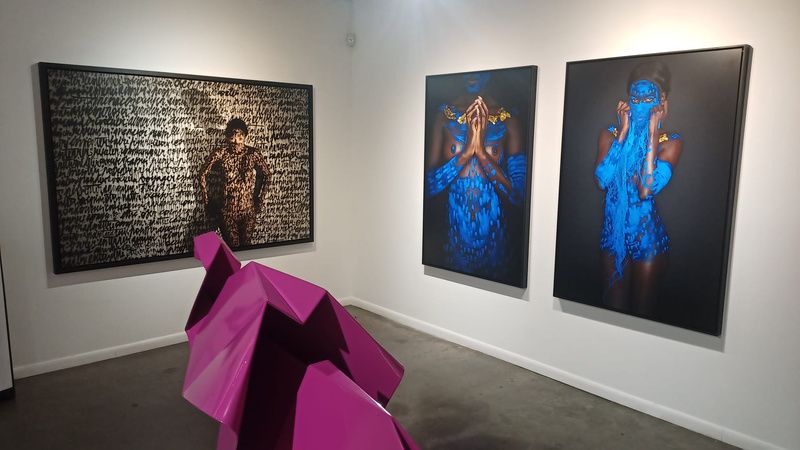
The Painters Project by Belgian artist Eric Ceccarini is an ongoing collection of collaborations with painters and models that has given birth to several distinctive photographs currently on display inside the Fremin Gallery. To create his work, Ceccarini invites models to become performing artists, with their bodies being used as a canvas. Both the photographer and painter work together to highlight the model’s persona and style. So far around 100 artistic meetings have taken place, but only a few have resulted in the creation of works of art.
For Ceccarini, The Painters Project has allowed him to explore unknown environments, experimenting with unusual shadows and highlights and an interactive canvas that is not only three-dimensional but also alive, breathing, and sentient. Each of the models’ poses and movements influences the design painted on them, forcing the body and art upon them to merge together as one. Visitors to the Fremin Gallery can view The Painters Project through January 8, 2022

In collaboration with the New York City Department of Transportation’s Temporary Art Program and Van Alen Institute, the Flatiron Partnership will present Atelier Cho Thompson’s art installation Interwoven in the Flatiron North Public Plaza. Inspired by New York’s tapestry of cultures and peoples, Interwoven is a series of interactive archways activated with color-coded sensors. When two or more people pass through sensors of the same color, Interwoven responds with the corresponding light and musical compositions by local artists.
The installation also features an interactive story wall made of backlit papers hung on a grid — allowing visitors to share responses to the prompt “I dream of a world where together we can…” which was selected by Youth Fellows from the People’s Bus NYC. Alongside Interwoven, four acapella performances by Christmas carolers will take place in the North Public Plaza. Interwoven was chosen through the eighth annual Flatiron Holiday Design Competition and will remain on display through January 2, 2022.

The NO I.C.E. Box is a life-sized public art installation modeled after the ice vending machines found in bodegas across New York City. Begun in 2019 as a multimedia concept, the installation’s design was chosen to help spark conversation about the United States’ current immigration policies and rhetoric. Created by design workshop Stop 1, in collaboration with the Museum of Contemporary African Diasporan Arts (MoCADA), The NO I.C.E. Box was funded by a Kickstarter campaign that has raised over $20,000 to bring the project to life.
A portion of each donation will also go toward funding immigration services offered at the New York chapter of Make the Road, a national non-profit organization. Some of these services include greater legal representation in immigration, housing, and worker exploitation cases, helping undocumented people gain U.S. citizenship, immigrant rights training, literacy programs, and ESL training. The installation will include digital interactive elements, a series of window displays alongside the installation, and museum-curated programming. It will be located outside MoCADA through March 2022.
According to Stop 1 founders Sajjad Musa and Roger Ferney Cortes, “Current U.S. migrant and immigration detention policies have eroded the principles of tolerance and inclusivity that underpin our social fabric and our common humanity. The NO I.C.E. BOX challenges these policies through nuanced art expression and encourages viewers to recognize the disparities between their personal identities and those of immigrants across the country. With backers’ support, we can amplify and deepen the discourse around immigration reform while building resilience among our immigrant communities.”
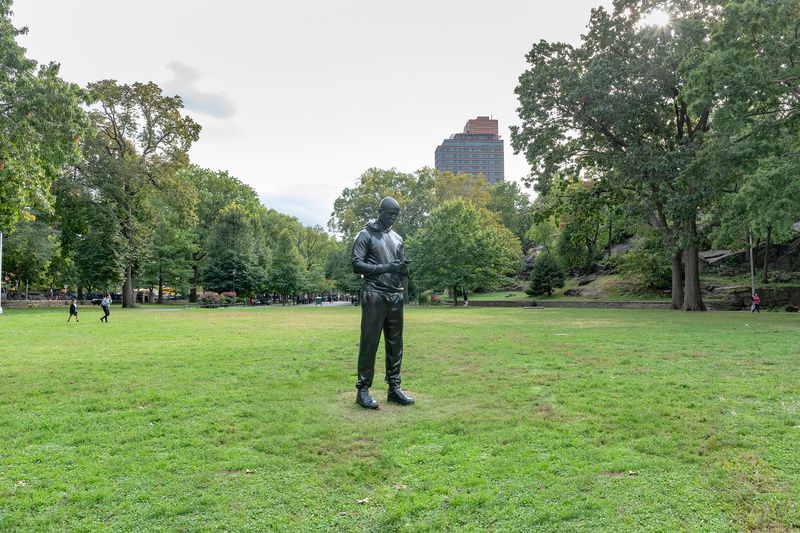
Situated within Marcus Garvey Park is Witness, artist Thomas J. Price’s first solo U.S. museum presentation. Witness features one monumental work titled The Distance Within, a nine-foot bronze sculpture depicting a young Black man looking down at his cellphone. Presented by the Studio Museum in Harlem, Witness celebrates ordinary blackness and asks its audience to consider the function of monuments as defining the familiar. The form of The Distance Within was inspired by Price’s earlier work Network, which was presented in 2013 in the U.K. and drew from the real people who lived and worked in the artist’s neighborhood of Brixton in South London.
In reference to the sculpture, Price stated that he wanted to “interrogate [notions of] presence, movement, and freedom. Whom do these spaces belong to? And what bodies are provided more or less autonomy to move with liberty through public [space]?”
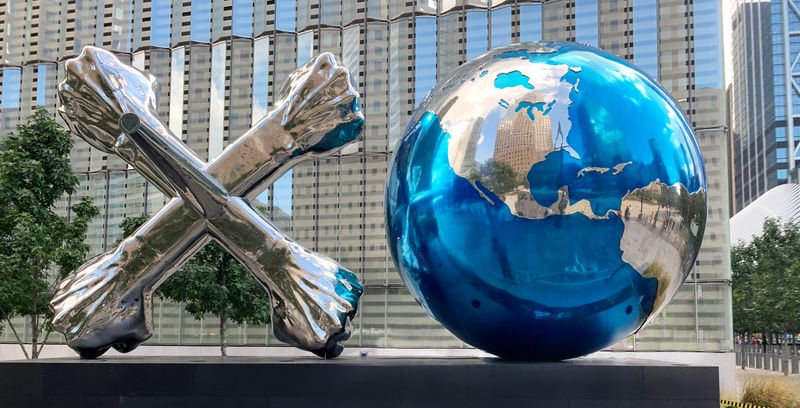
XO World Project consists of two monumental sculptures at the World Trade Center Campus. Designed by artist Daniel Anderson, XO World and XO Play promote messages of inclusivity, hope, and positivity among their viewers. Both sculptures were inspired by the widely played game Jacks. The “X” of XO World is represented by a Jack with crossed arms attached to the spoke — simultaneously being a reference to the word “love” in sign language. On the other hand, the “O” is represented by a globe.
As a whole, XO World is 12 feet tall, 24 feet wide, and made from more than 20,000 pounds of stainless steel. In conjunction, XO Play showcases the unity of all races and the acceptance of children. Its cross-armed jacks symbolize security and safety while a little girl holds a ball reflective of a globe in her hand, symbolizing the impact she stands to have on the world. XO World can be found in front of One World Trade Center on the West Plaza at 285 Fulton Street while XO Play is located inside the Oculus at the World Trade Center. Both XO World and XO Play will remain in New York until they are moved to Paris in 2022. After Paris, the sculptures will be displayed in London, Hong Kong, Moscow, and Dubai.
According to Anderson: “Launching this in the epicenter of the world, New York City, where people come from all different cultures, has created a viral movement of positivity amongst people. It’s working and that is exciting. My inspiration for these sculptures came from children and their open acceptance of others. A child’s mind and heart are free of prejudice regardless of race, gender, or religion, which is something we should all emulate. ‘XO World Project’ will bring people together for many generations to come.”
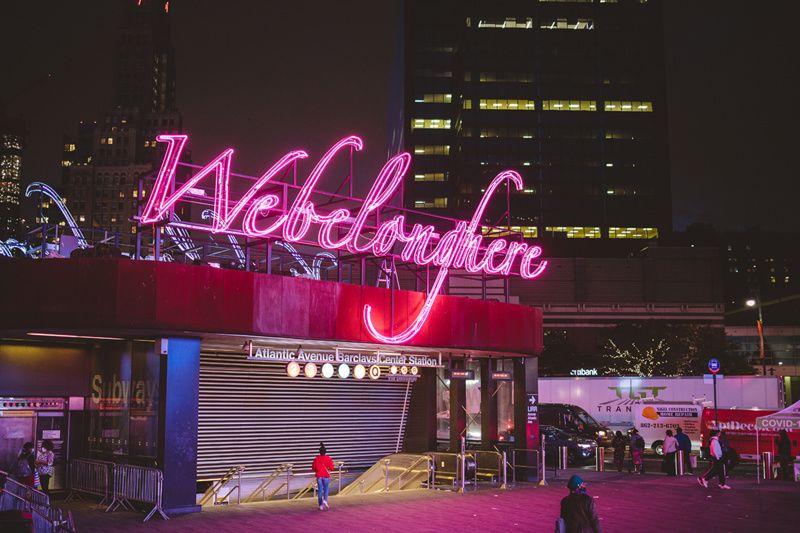
At the intersection of Atlantic and Flatbush Avenues in Brooklyn, on the plaza outside the Barclays Center, is Belong / Brooklyn, which consists of one pink and one white neon sign created by Bahamian artist Tavares Strachan. The sign reading “You Belong Here” greets visitors, and upon leaving, the second sign states “We Belong Here.” Strachan collaborated with Clara Wu Tsai, a philanthropist and criminal justice activist behind The Joe And Clara Tsai Foundation’s Social Justice Fund.
The phrases on both signs hold significant meaning at the Barclays Center, where waves of protesters gathered following the death of George Floyd in 2020. In addition, the signs can also be viewed as a call back to earlier protesters who attempted to fight against the construction of the Atlantic Yards development, which the arena anchors, after its announcement in the 2000s. Since 2008, rent and commercial prices in this part of Brooklyn have skyrocketed, and the Barclays Center in particular has become a symbol of the area’s gentrification. Tavares’ work asks audiences to question who is truly allowed to call New York City their home.
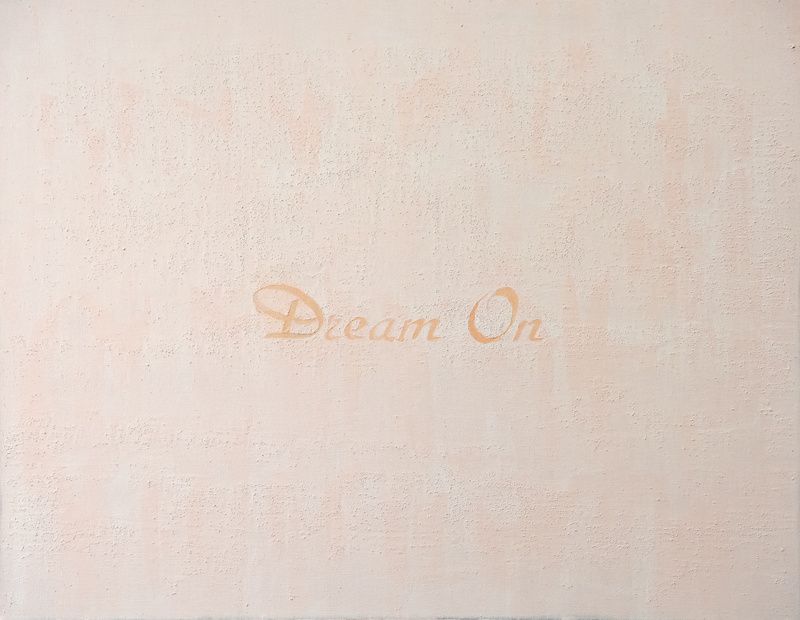
Located in the Kaufman Arcade Building on 138 W. 35th Street, Stu.pe.fac.tion is a series of seven paintings created by artist Joanne Handler. Stu.pe.fac.tion was curated as part of the Garment District Alliance’s Space for Public Art Program, which over the past 16 years has worked to showcase artists in unusual locations.
Handler was inspired by the emotional turmoil and deep introspection surrounding the pandemic and 2020 election while creating Stu.pe.fac.tion. Each painting is named after a song, and some have the title or lyrics in the piece itself. Some example song names used include “American Idiot” by Green Day, “Times Like These” by the Foo Fighters, and “Dream On” by Aerosmith. The series will be on display through January 7, 2022.
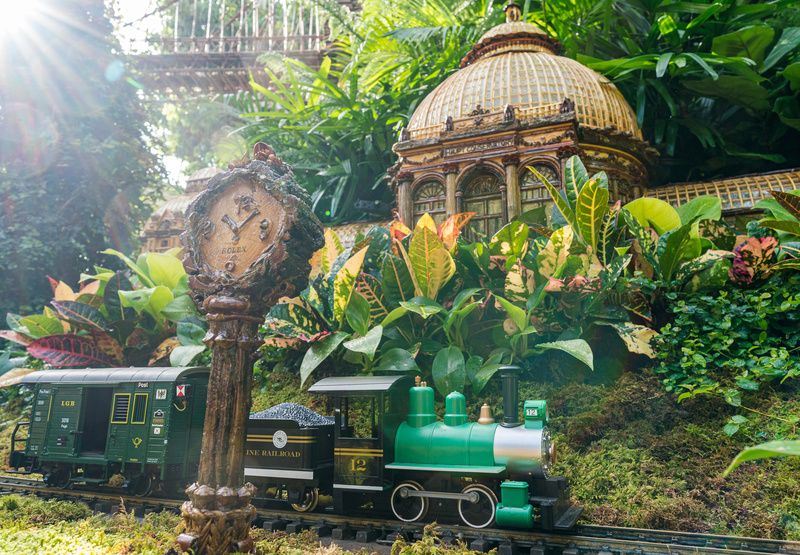
This November the Holiday Train Show will return to the New York Botanical Garden (NYBG) for its 30th anniversary. Visitors will have the opportunity to marvel as model trains zip through a display of more than 175 New York landmarks, each having been recreated from natural materials such as birch bark, lotus pods, cinnamon sticks, cones, acorns, and seeds. Inside the Enid A. Haupt Conservatory, a miniature wonderland will feature classic New York structures like the Empire State Building, Brooklyn Bridge, and Rockefeller Center. In honor of the show’s 30th anniversary, a new replica of the LuEsther T. Mertz Library and Haupt Conservatory has been created. The Holiday Train Show will run through January 23, 2022.
On 25 select nights starting November 24, 2021, until January 22, 2022, NYBG GLOW will light up the Botanical Garden. Around 1.5 miles of the Botanical Garden will be filled with washes of bright colors, thousands of energy-efficient LED lights, and illuminated plant stories, with the Haupt Conservatory and Mertz Library Building serving as the centerpieces. During NYBG GLOW nights, beverages and light fare will be served at the outdoor bars or the Bronx Night Market Holiday Pop-Up. To celebrate the holiday season, ice sculpting, music, and pop-up performances will be available around the garden.
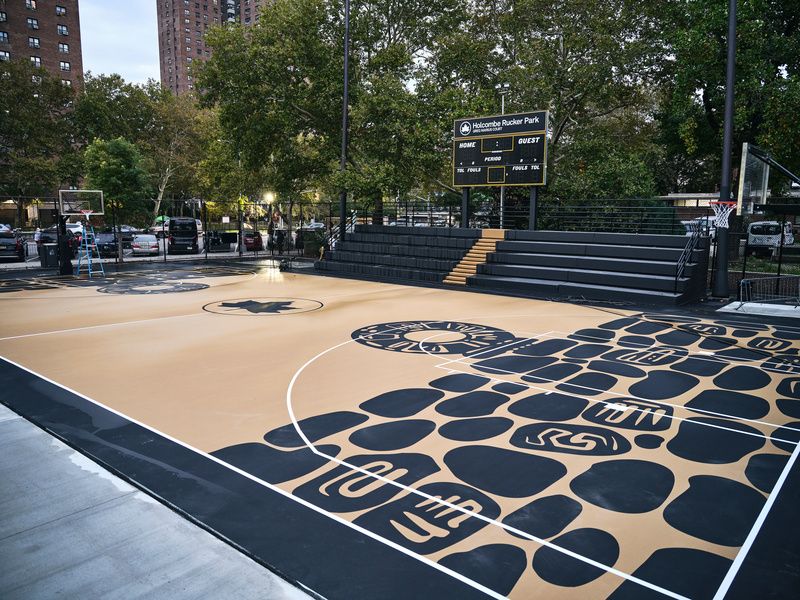
Over the past few months, the National Basketball Player Association (NBPA), local community leaders, and brand partners undertook the task of completely renovating the historic Greg Marius Court at Holcombe Rucker Park in Harlem. As one of the best-known basketball courts in the United States, Greg Marius has become a rite of passage for basketball players growing up in New York City. Renovations included the leveling of the court’s pavement, replacement of the bleachers, backboards, baskets, and scoreboard, the addition of team benches on both sides, and the repainting of the court with a brand new mural known as The Warrior.
Created by Harlem native and renowned rapper A$AP Ferg and curator Set Free Richardson, The Warrior pays homage to the warrior spirit of the Harlem community while embodying the essence of many past, present, and future basketball players.
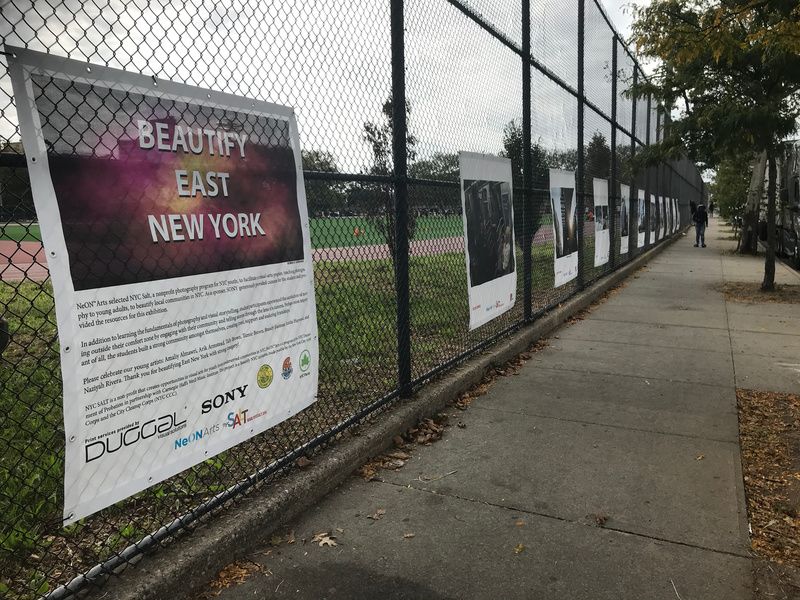
This fall, Beautify NYC — an initiative of the City Cleanup Corps (CCC) which plans to directly create 10,000 jobs and make New York one of the greenest and cleanest cities in the United States — will showcase Beautify East New York, an outdoor public photography exhibition in Linden Park. For the creation of the exhibition, Beautify NYC partnered with NeOn Arts, a free program of the NYC Department of Probation that offers young people in seven New York City communities the opportunity to explore the arts through creative projects, establish positive peer relationships, and develop critical social and career skills.
The exhibition will feature work from young emerging New York City artists who have graduated from NYC SALT’s visual arts program for underserved city youth. Featured work aims to engage the neighborhood’s youth in strength-based activities supporting their educational and employment outcomes. Photographs will celebrate the people and culture of the neighborhoods.

On display through September 30, 2022, is The Ribbon, a playful interactive platform that invites passersby to connect with Long Island City admirers. The work aims to break down barriers and connect people through moments of open-ended play while also serving as a place for people to stop and engage in fruitful conversations with one another.
The Ribbon has been erected in two public spaces across the Central Court Square area. Each location of The Ribbon features two magenta structures with rotating iridescent panels inscribed with “LIC Love Notes” written by locals. Notes will be continually added to the structure through December 2021 or until all 100 panels are filled. On-site, a QR code is available to contribute a note for the installation. Designers for The Ribbon include Hive Public Space and The Urban Conga, and the project was commissioned by the Long Island City Partnership.

Presented by DIX2, Big Apple is a temporary public art installation in Bella Abzug Park in Hell’s Kitchen. Created by designer Felix Marzell, Big Apple will serve as a new meeting place in the heart of the bustling city, with benches inside allowing visitors to sit within the wooden structure. Whether alone or in a group, Big Apple makes for a perfect spot to come together and create new shared stories and experiences.
On view for the next 11 months, Big Apple‘s structure is made of various layers of coated plywood fixed around a central axis with each wooden wedge being designed to create one seat once assembled. The sculpture is presented by the Hudson Yards Hell’s Kitchen Alliance with support from NYC Parks and funding from the Québec Government Office in New York and Amazon NYC.
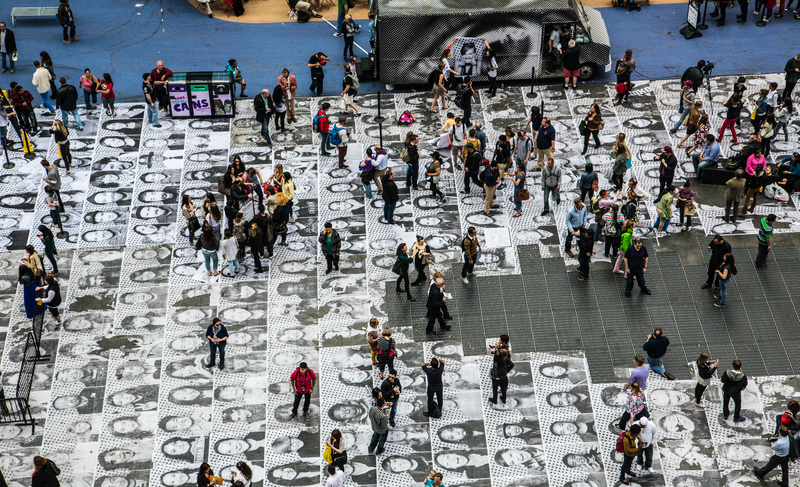
Launching October 3, Inside Out: NY Together is an outdoor gallery — and part of the Inside Out project conceptualized by French artist JR — that celebrates the diverse individuals who make up New York City. Over the preceding five days, passersby through the Garment District will be able to have their photos taken on 40th Street between 8th and 9th Avenues. These black-and-white photos will then be printed in real-time and featured outside the Port Authority — representing the disparate walks of life encompassed by New Yorkers. The gallery is projected to feature portraits of more than 1,200 everyday New Yorkers and measures 40 feet high and 600 feet wide. Inside Out: NY Together will be presented by the Garment District Alliance and the Port Authority of New York and New Jersey.
According to Port Authority Executive Director Rick Cotton: “This outdoor mural will weave inspirational and dynamic public art into the exterior of the bus terminal in cooperation with the local community to dazzle both bus riders and local residents.”

This fall, interdisciplinary artist, writer, and educator Jeff Kasper will debut two new mural installations he calls Soft Spots. The murals will be presented by Not a Monolith — a public art and professional development initiative created in partnership with ArtBridge, Facebook Open Arts, and We The Culture, which amplifies the voices of New York-based Black artists. Soft Spots’ design involves a series of colorful paths inspired by the playful style of self-help and mutual aid graphics that became popular during the pandemic. Along each path, the colors switch from cool to warm and change in size from small to large.
In addition, the murals subvert the visual language of “social distancing” vinyl floor signage, compelling viewers to further contemplate the challenges we face in seeking support while feeling unsafe. Both murals are accompanied by an audio guide featuring affirmations and visualizations to foster a sense of self-confidence and to decrease social anxiety in viewers. The first mural is located in Queens at the Rockaway Beach Boardwalk, and the second is in Staten Island at the Stapleton Waterfront. Both will be on display through March 18, 2022.

As an additional pop of color, the MTA has unveiled Queens of the Night and No Less Than Everything Comes Together, two permanent mosaic series inside the 1st Avenue and Bedford Avenue L train stations. Created by artist Katherine Bradford, Queens of the Night serves as a tribute to the creatives and essential workers who ride the L train daily. Located in the East Village at the 1st Avenue station, the ethereal figures in Bradford’s work come together to inspire viewers to consider the outward expression of their own interior vivacity. One of the most striking panels from Queens of the Night is “Superhero Responds,” portraying New York’s essential workers in the style of Superman.
Situated in Williamsburg at Bedford Avenue, No Less Than Everything Comes Together features theatrical fairy-like figures under the sun and moon. Created by Marcel Dzama, scenes depicted in No Less Than Everything Comes Together are populated with elegant ballet performers, many of whom are adorned with the black-and-white costumes typically worn by NYC Ballet dancers. Scattered throughout the mosaic series are numerous characters representing infamous Brooklynites including Bugsy Siegel and Captain Jonathan Williams — the founder of Williamsburg.

Inside the new 42nd Street Connector between Times Square and Grand Central is Every One, the first of a three-piece installation by artist Nick Cave. Commissioned by MTA Arts & Design, the installation was created as part of the 42nd Street Shuttle reconstruction and reconfiguration project, costing the city more than $250 million. The figures were made from recomposed source photos of soundsuits taken by James Prinz, which were then interpreted in glass for display on the subway station’s walls.
Every One’s design features a series of figures wearing colorful soundsuits — costumes that camouflage the shape of the wearer. Taking inspiration from African art traditions, ceremonial dresses, and haute-couture fashion, soundsuits are unique in that through covering the entire body, they conceal the wearer’s gender, race, and class, which eliminates audience judgment throughout the performance. Throughout the installation, the figures can be seen jumping and twirling along the wall, with their suits swaying as if moved by the wind. The other two parts of Cave’s installations, Each One and Equal All, will be installed next year at the new shuttle entrance and on the center island platform wall at Grand Central Terminal respectively.
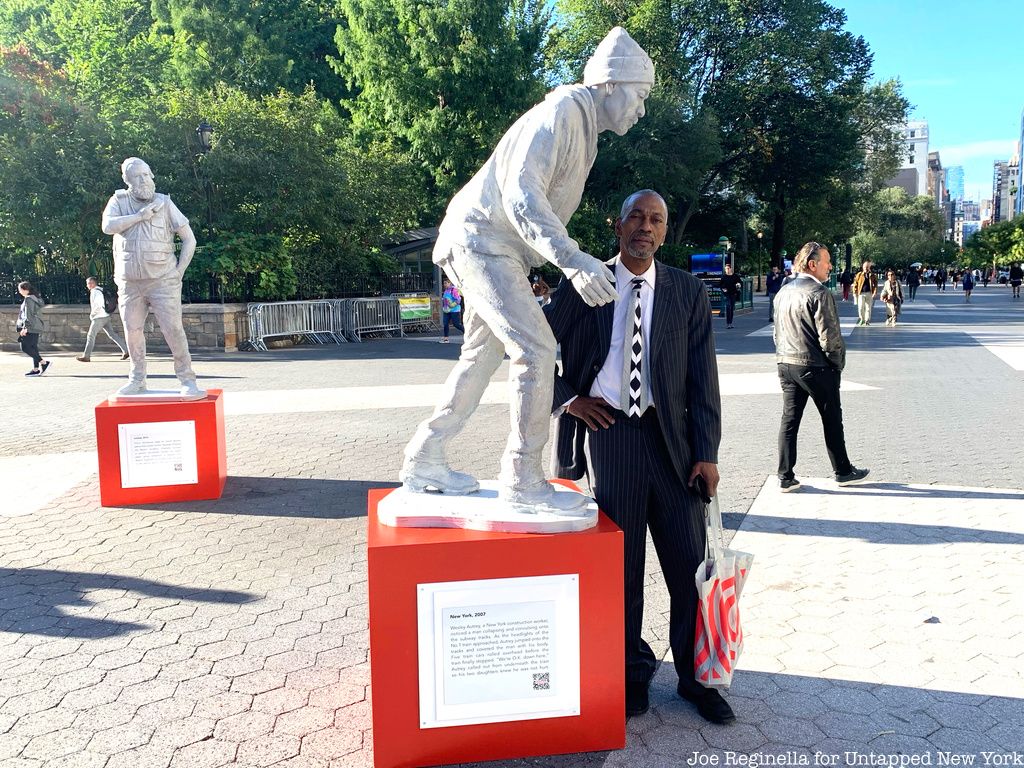
In New York City this October, the organization I Am Your Protector will present Protector Monuments: Reclaim The Pedestal — a series of five sculptures depicting everyday individuals who have stood up for those around them. Created by artist Joe Reginella and sculptor Alvin Petit, these monuments are intended to help reclaim public spaces for people of color, minorities, refugees, immigrants, and women. Protector Monuments: Reclaim The Pedestal, hopes to inspire other people to go out and become protectors within their own communities. To do so, the sculptures have been placed on three-foot-high pedestals to celebrate the individuals and ensure they are looked up to by society.
The five individuals memorialized in the sculptures are Wesley Autrey, Isra Daraiseh, Chaim Hochhouser, Mohsen Alwais, and Antonio Diaz Chacon, whose heroic actions saved lives. A sixth pedestal will also be placed but left empty, so visitors can share their unique stories and those of individuals who have helped or protected others. Intended to be mobile, the sculptures will be moved to various currently undisclosed locations throughout the city over the next few weeks. Afterward, they will travel across the United States, heading to cities like Nashville, San Francisco, and Washington D.C.

Beginning October 8th, The Trust for Governors Island will present artist Mark Dion’s new installation, The Field Station of the Melancholy Marine Biologist. On long-term view in Building 105 — a historic arsenal structure located within the Governors Island Historic District — The Field Station of the Melancholy Marine Biologist transforms the space into an abandoned research outpost. Scientific objects, instruments, artifacts, and samples featured in the installation were chosen for their connections to Governor Island’s history and the ecology of the New York Harbor and Buttermilk Channel.
For Dion, the installation allows viewers to witness a scene preserved in time, one “where somebody studying the natural world realizes that the future’s not looking so good… that we are going to lose a great amount of the natural wonders that have been here in previous centuries.”

Throughout Lower Manhattan, the public-artspace nonprofit ArtBridge has turned 65 lamp posts into temporary art installations exploring the theme of resiliency. One selection of featured work includes Dances of New York City by Frances Smith. As the name suggests, Smith’s work features breathtaking illustrations of dancers atop colorful backgrounds of key New York City landmarks and iconographies such as the Brooklyn Bridge and subway entrance. With 10 total illustrations, Dances of New York City highlights traditional dance techniques while simultaneously showcasing relatable New York moments such as the “Pizza Soca,” “The Village Cross,” and “Upper West Side Swing.”
Another featured work on display is Geo Grid by painter Michelle Weinberg. Geo Grid expertly utilizes the cylindrical shape of the lamp posts to highlight patterned art. Through the usage of vividly colored geometric shapes, Geo Grid showcases movement as it swirls upward. Art for the lamp posts was selected through a public design competition held this past summer that received more than 100 submissions.

Through May 31, 2022, Brooklyn-based artist Emily Oliveira’s new mural We Are At a Moment That Will Be Remembered as the Beginning of the Great Change, For Who Can Say When a Wall Is Ready To Come Down will be on display at the Lena Horne Bandshell in Prospect Park. Presented by BRIC and Prospect Park Alliance in partnership with NYC Parks’ Art in the Park Program, the 28-foot tall mural depicts a vividly colored natural landscape inhabited by humans and gods partaking in a Promethean sense of rebirth. We Are At a Moment That Will Be Remembered… encourages viewers to use their imagination to envision and enact new ways of being in a post-COVID-era world while simultaneously celebrating the collective action against violence, hate, and separation that has taken place over the last year.
In the view of Jenny Gerow, curator of the mural and Contemporary Art Curator for BRIC, “Emily Oliveira offers a utopian vision of a future that tantalizes but doesn’t overpromise. As the title reflects, who can say when the wall is ready to come down? Still present in the foreground and the background are the remnants of the present, systems of hierarchy and oppression. The artist is masterful in the art of seduction, often achieved in her textile-based work, through the use of shiny and silky textiles and embroidery, but here created through vibrant color and the temptation of touch and care we all have longed for over the past year.”

In Christopher Park, a bust of Black transgender LGBTQ activist Martha P. Johnson was recently erected on August 24th, which would have been her 76th birthday. Today, Johnson is known for her crucial role in the 1969 Stonewall Riots and for co-creating with fellow transgender activist Sylvia Rivera the Street Transvestite Action Revolutionaries (STAR), which sought to provide housing for LGBTQ youth. Later, Johnson served as a staunch activist for survivors during the AIDS crisis before her death in 1992. The city announced in 2019 that it planned to create memorials near the Stonewall Inn for Johnson and Rivera, but these plans never came to fruition. However, rather than continuing to wait for the city to make due on its promise, writer and activist Eli Erlick, sculptor Jesse Pallotta and a number of fellow organizers created a bronze bust of Johnson and installed it inside the park. Additional help in creating the bust was provided by Tourmaline, an artist and filmmaker whose hundreds of archived photos of Johnson gave Pallotta a deeper understanding of her features from every angle.
The bust features Johnson softly smiling with a colorful flower tiara adorning her head. Below the bust is a plaque that honors Johnson’s love of poetry, flowers, space and the color purple. It includes a quote which reads, “History isn’t something you look back at and say it was inevitable. It happens because people make decisions that are sometimes very impulsive and of the moment, but those moments are cumulative realities.” Currently, it is unknown as to how long the bust will remain in the park, but it was specifically designed with the intention of only being up temporarily. It is Erlich and Pallota’s hope that the bust will inspire the city to follow through with creating monuments to Johnson and Rivera and involve Black trans women leaders in New York City in the design process.
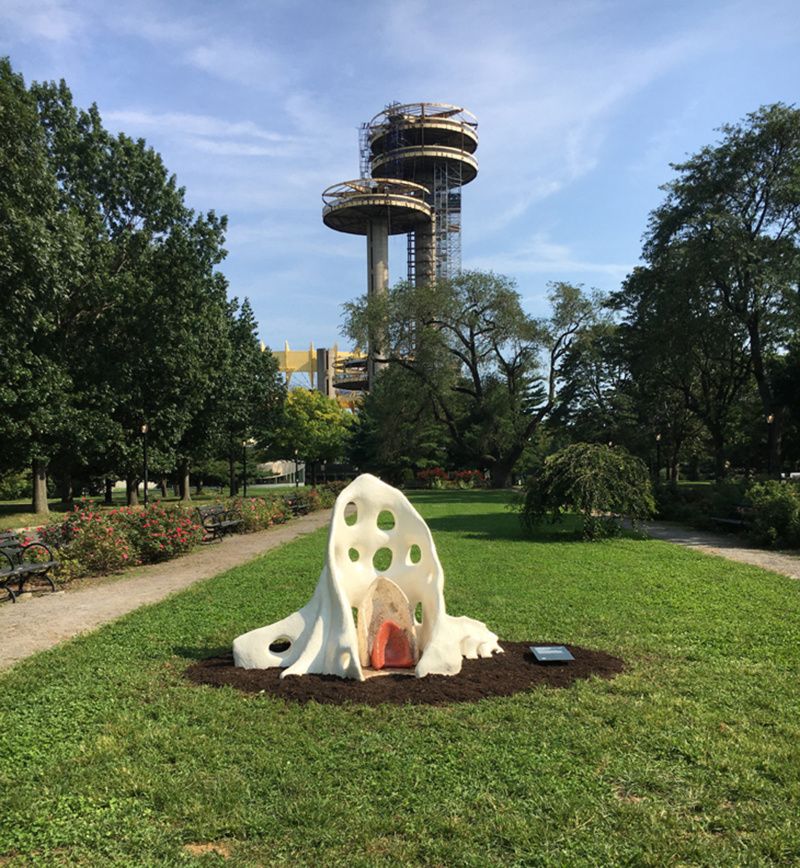
Through August 10, 2022, Endangered Fossils by Judith Modrak will be on display at Flushing Meadows-Corona Park in Queens. Endangered Fossils features a series of sculptures meant to represent an imagined archeological excavation of New York State’s fossil record. Inspiration for the sculptures was drawn from trilobites, brachiopods and crinoids present from the Devonian period 400 million years ago — which today can be recognized for their similarities to modern crabs, clams and starfish. Each sculpture prompts its audience to consider the origins of our ecosystem.
As Modrak writes in her artist statement: “The larger concept was very much about the fossil record in light of disastrous climate change which is causing many species to tragically become extinct, fossils are even “endangered” as certain species may not leave a trace that they ever existed. Endangered Fossils is a homage to our beloved Mother Earth in a critical time requiring immediate attention.”
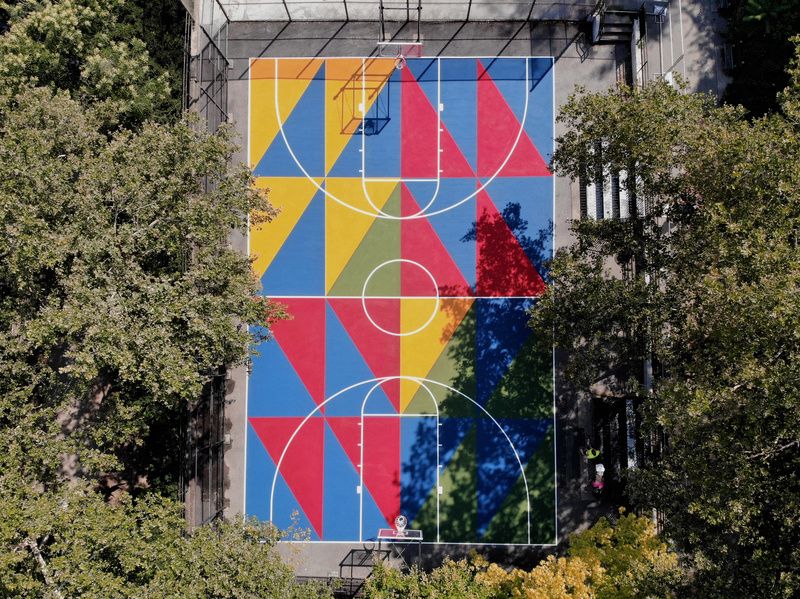
In a basketball court at St. Nicholas Park in Manhattan is Faith Ringgold’s muralWindows of the Wedding #1: Woman. The mural is part of Ringgold’s ongoing Windows of the Wedding series, which began during the 1970s after the artist began experimenting with abstract shapes. Ringgold would go on to receive critical acclaim during the 1980s for her narrative quilts.
Presented by Project Backboard, Windows of the Wedding #1: Woman’s design features a vibrant array of colors painted next to one another in triangle shapes of various sizes. It will be up for view through August 8, 2022.
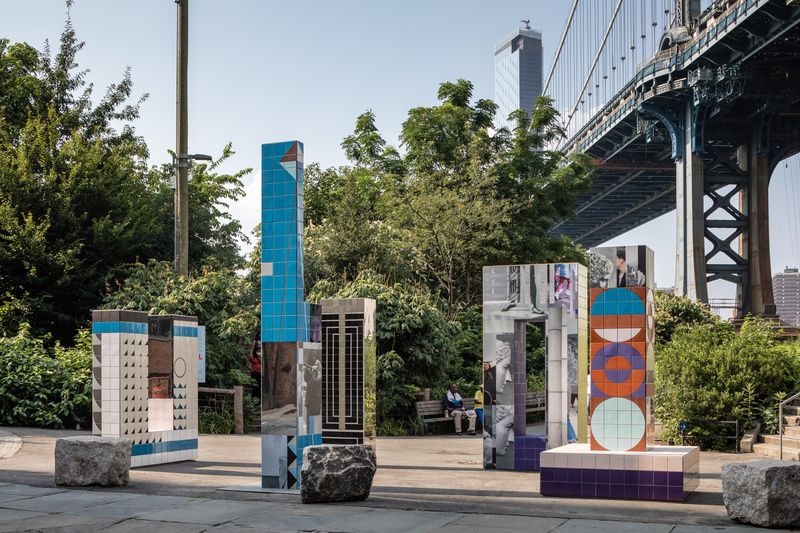
Scattered around the iconic terminus of Washington Street in Brooklyn Bridge Park’s Main Street Park section — where the Manhattan Bridge perfectly frames the Empire State Building — is Rehearsal, the public debut for Berlin-based artist Claudia Wieser. Presented by the Public Art Fund, Rehearsal will feature five distinct large-scale geometric sculptures made from mirror-polished stainless steel, reflecting the movements of visitors as they pass by. Ranging in height from 7 to 13 feet, the sculpture’s warm and cool-toned hand-painted glazed clay tiles define each sculpture. At the same time, they also echo the patterns of neighboring historic red buildings and Belgian-block paving stones. As a further connection to its surroundings, Rehearsal includes contemporary photographs of New York City and slides of a German family’s trip to the city from the 1980s. Reproductions of ancient Roman and Greek antiquities endow the installation, serving as a meeting place and theatrical setting much like ancient Roman forums once did. Moreover, the title ‘rehearsal’ draws attention to the interplay between visitors and artwork, suggesting that the sculptures and even life itself are ever-evolving processes. Rehearsal will be on display until April 17, 2022.
As Public Art Fund Associate Curator Katerina Stathopoulou (Rehearsal’s curator) states in the artwork’s press release: “Wieser is acutely aware that the sculptures will become part of the landscape of the city for a time and wanted to create a powerful synergy with the bustling surroundings of DUMBO. Building a dialogue between the public and the sculpture is an integral part of Rehearsal… Park-goers will activate the works by touching, resting, and seeing themselves and the city reflected as they weave their way through the constellation of sculptures.”
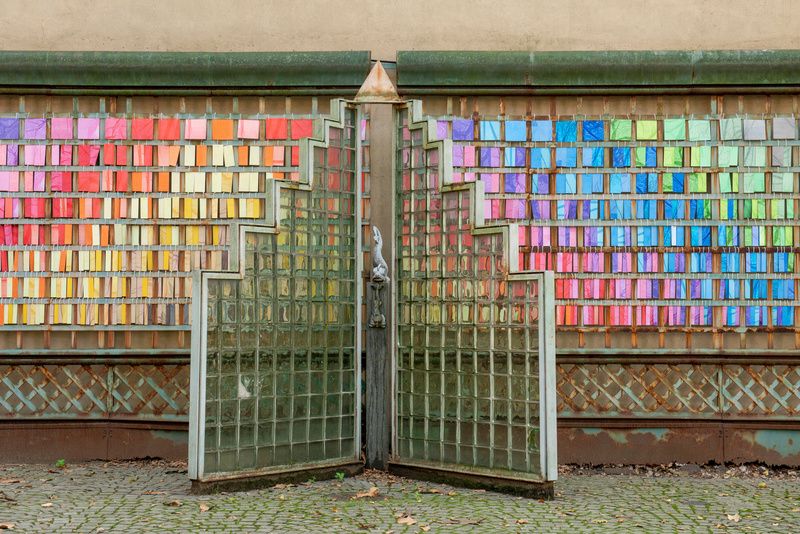
While walking through Harlem Art Park, visitors can marvel at Capucine Bourcart‘s Plastic Fantastic. Measuring 66-feet wide and 7-feet high, Plastic Fantastic’s grand scale illustrates the abundance of single-use plastic and how it has adversely affected our environment and public spaces; New York City residents are estimated to use more than 10 billion single-use plastic bags a year. Plastic Fantastic aims to support the city’s current ban on plastic bags while encouraging residents to take responsibility for their environmental footprint.
To convey this, the installation features plastic bags collected over the last few years by Bourcart from community residents and neighbors. To create Plastic Fantastic, these bags were photographed and printed on 4’ x 8’ sheets of D-bond, a lightweight and durable plastic material. Afterward, the sheets were cut into smaller squares and rectangles to create a color gradient woven into the grid of the park’s ornamental fence. In front of the gradient is a glass block structure which perfectly reflects the colorful background. Funding for the installation was provided by the LMCC, Puffin Foundation, and Friends of Art Park Alliance. Plastic Fantastic will be on display through June 26, 2022.
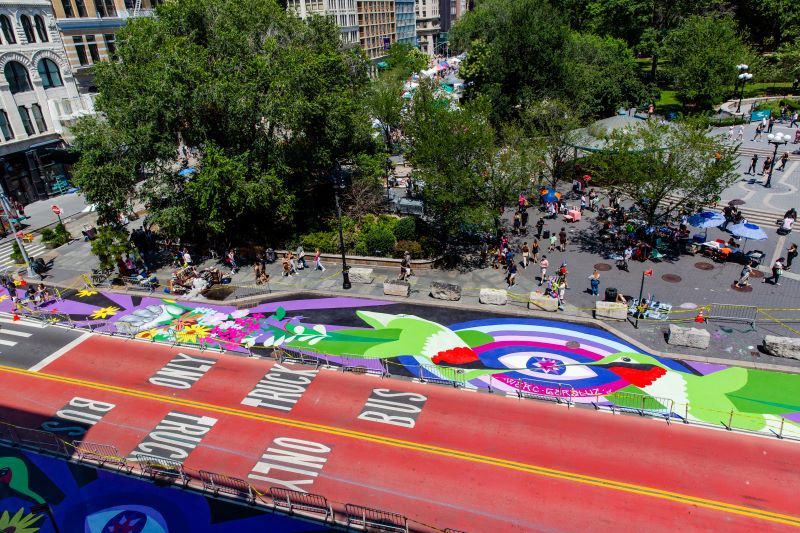
Collective Vision is a 7,500-square-foot mural presented by street artists Geraluz and Werc (a Brooklyn-based couple) painted in the pedestrian areas of the 14th Street busway between Broadway and Union Square West. Presented by the Union Square Partnership and the New York City Department of Transportation’s Art Program, the mural addresses themes of nature, unity and resilience. It will be installed over the course of 4-5 days beginning July 27 with the help of 20-30 volunteers who will hand-paint the large shapes and background colors.
Collective Vision works to recognize the history of social movements fighting for justice within Union Square and the larger struggle for racial equality in the United States. As an example of this, the mural includes a striking rendition of the Black power fist surrounded by an array of vibrantly colored flowers. At the same time, the mural will also celebrate the community that public spaces have helped shape and their role in fostering activism and collective experiences.
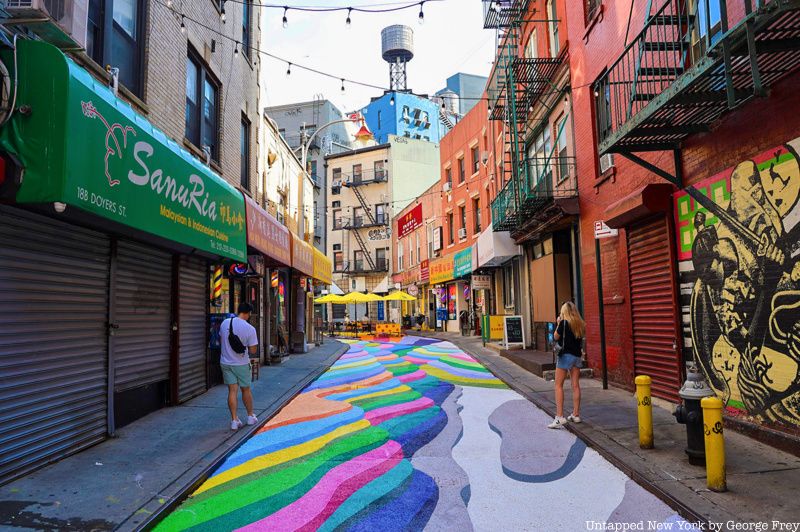
In honor of Pride month, Chilean-born street artist Dasic Fernández painted the historic Doyers Street in Chinatown in a range of beautiful colors from all across the rainbow. In the past, Doyers Street was once known as “the Bloody Angle,” for the amount of gang violence that took place in the early 20th century. The breathtaking mural that now covers the street spans 4,851 square feet in length and includes 44 unique colors, painted across a period of just three-and-a-half days. Fernández received information for the mural’s design from rice cultivation terraces—a common landscape seen throughout China. Using the Anamorphism technique, the mural appears 3D at certain points, most notably from the corner of Pell or Bowery streets, perfectly integrating the mural into its surrounding environment.
Doyers Street’s vibrant makeover is part of New York City’s Asphalt Art Activation series, which involves the partnership between NYC Department of Transportation (DOT) and artists to paint large scale-murals onto repurposed asphalt that are pedestrianized public spaces. Typical sites the program has transformed include curb extensions, slip lane closures, bike share lanes, and temporary plazas, with sizes ranging anywhere from 1,000 to 8,000 square feet. In addition, as part of the city’s Open Streets program, Doyers is fully closed to all vehicular traffic from Bowery to Pell streets daily from noon to 11:00 p.m. Given this, Doyers Street serves as the perfect venue for visitors to walk through and enjoy Fernández’s mural. The mural will be on display for the following 11 months, weather permitting.

The Fabulous Plant of Rejuvenation is a 90-foot-tall mural by Baxter St alum Ivan Forde, located on the façade of the newly built Rockaway Hotel in Rockaway Beach, Queens. The mural was curated by Michi Jigarjian, Managing Partner, Creative/Social Impact Officer, with support from 7G Foundation and Facebook Open Arts. Inaugurated on June 18th, 2021, the artwork draws inspiration from the legacy of Rockaway‘s’ Indigenous Lenape people and Forde’s own ancestry — including conversations with his father on the healing powers of water and vegetation. Included in the mural is a depiction of an underwater seascape of poetic sea characters alongside local fish and birds. Its centerpiece is the mythical plant from the ancient Mesopotamian poem The Epic of Gilgamesh. In addition, the mural features a series of healing plants, connected to Forde’s birthplace of Guyana, the Rockaways, and other cultures across the globe.
“My project takes cues from the structures of epic poetry, conversations with ecologists and botanists, and folk traditions our grandmothers and great-grandmothers knew,” Forde said. “These knowledge systems are paramount to the discussions the mural aims to hold space for and align with a symbiotic relationship to nature essential for healing both the human species undergoing a global pandemic and the planet itself.”
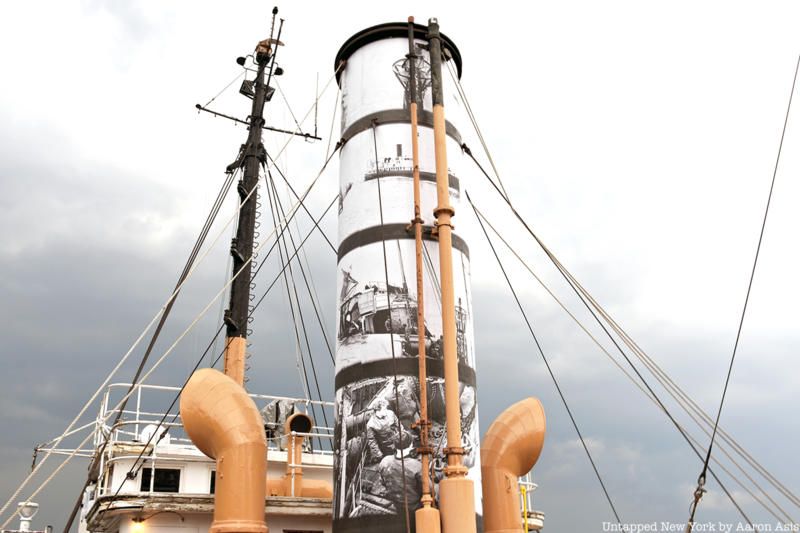
A new mural titled 88 LILAC celebrates the history of the LILAC on Pier 25 in Lower Manhattan. The LILAC is a retired Coast Guard cutter that maintained buoys and carried supplies to lighthouses from 1933-1972. The paper mural, created by Aaron Asis, Untapped New York’s Artist in Residence, displays large-scale historic images wheat-pasted along the ship’s historic stack. When up close, you can listen to a dramatic account of an important moment in LILAC’s history titled “Aids to Navigation,” written by Untapped New York’s Chief Experience Officer Justin Rivers. The public can access the experience via a QR code on Pier 25 while viewing the mural.
As America’s only steam-powered lighthouse tender, revitalization efforts for the LILAC are run by the non-profit LILAC Preservation Project. Its goals are to rehabilitate the ship to operate once again on its original steam engines, promote maritime education, provide a venue for history and art, and offer a community-friendly space for meetings and events. The grand re-opening of the museum ship is slotted for July. In the meantime enjoy a view and a story about its history from the fresh air of Pier 25 in Lower Manhattan.

The Roots of Tuckahoe Marble is an 8-foot-tall public sculpture made of Tuckahoe marble, bronze, and glass by Lara Saget. Historically used for building many of New York’s iconic landmarks like Washington Memorial Arch in Washington Square and Manhattan’s historic New York Marble Cemetery, the story and the supply of Tuckahoe marble have been lost.
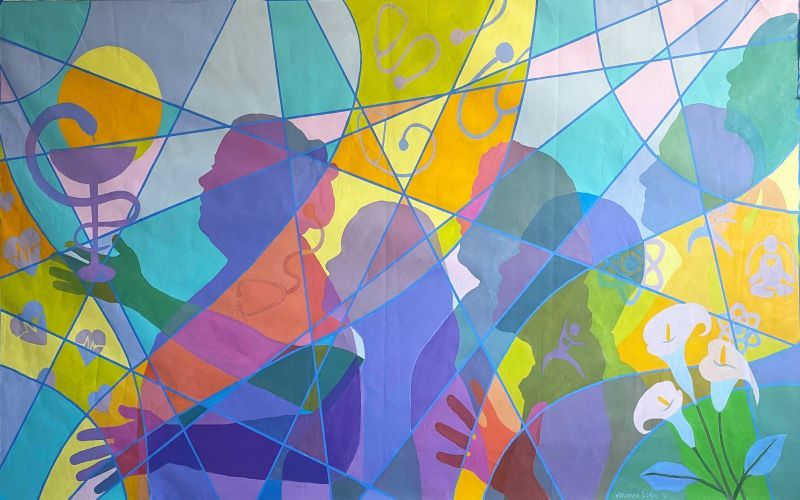
The Community Murals Project of the New York City Health + Hospitals system has unveiled four new murals. Artist Viktoriya Basina created three new murals at Gotham Health/Dyckman Hospital in Inwood celebrating the Dominican community as well as the heroism of the hospital staff. Also unveiled this month is the mural For the People By The People by Daryl Myntia Daniels. Located in the Pediatric waiting room of Gotham Health Sydenham, it depicts notable figures associated with the history of Sydenham and street signs from the Harlem area where the former hospital is located. All the murals were created with community input.
When complete, The Community Murals Project will be the country’s largest public hospital murals program since the Work Progress Administration/Federal Art Project in the 1930s and 1940s. As part of the NYC Health + Hospitals Arts in Medicine program, the project encourages community participation with an artist leader. By the end of summer, there will be 27 murals across the hospital system.
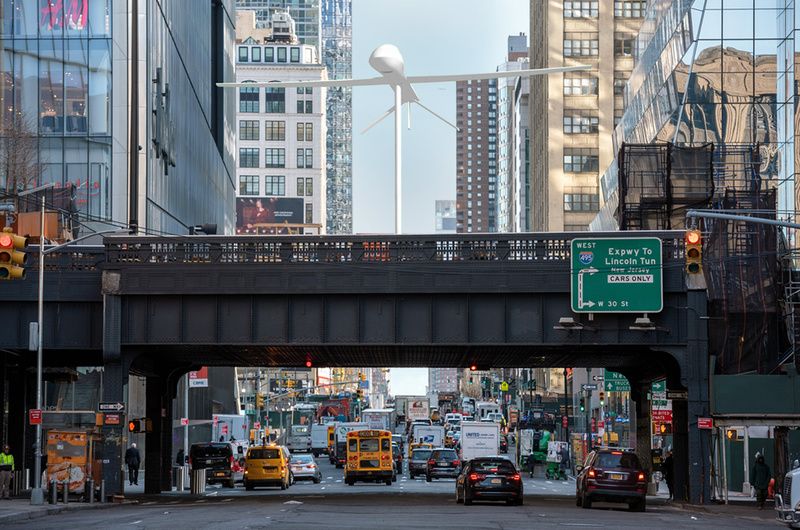
One of several public art installations along The High Line, Sam Durant’s Untitled (drone) is the second High Line Plinth commission. With this work, Durant seeks to make visible the intentionally obscured drone warfare perpetrated by the United States, and to remind the public that drones and surveillance are a tragic and pervasive presence in the daily lives of many living outside—and within—the United States.
This large-scale fiberglass sculpture in the shape of an abstracted drone atop a 25-foot-tall steel pole continues High Line Art’s mission of presenting new, powerful, and thought-provoking artworks that generate and amplify some of today’s most important conversations Untitled (drone) is on view through August 2022.
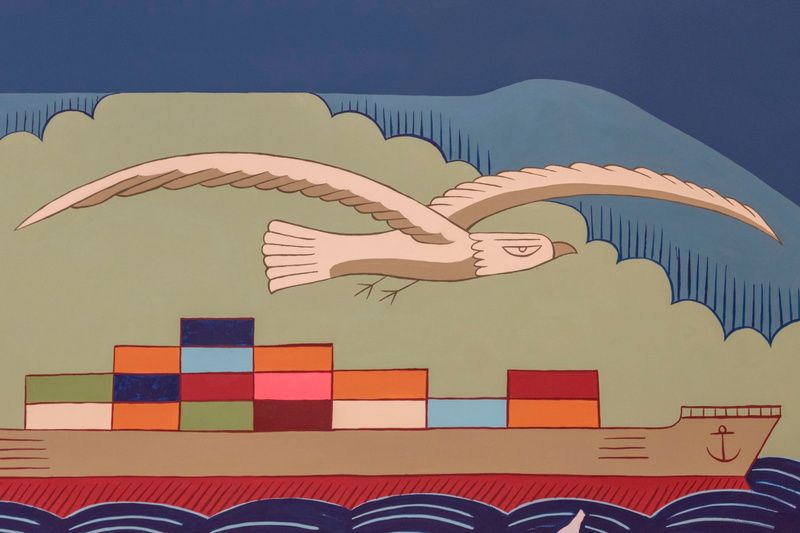
In his large mural work for the Governors Island Ferry Building, artist Duke Riley expands on the ships in a bottle tradition of preciously crafted objects by using a more common bottle of today—single-use plastic containers found floating in oceans worldwide. However, unlike their blown glass and wood-ship-in-a-bottle counterparts, Riley’s painted vignettes appear etched like scrimshaw on the surfaces of items that plague our waterway ecosystems, such as detergent bottles and caulking tubes.
“As a historic center for the arts, Governors Island is proud to welcome yet another celebrated artist to enliven our public spaces,” said Clare Newman, President and CEO of the Trust for Governors Island. “Riley’s work marries the Harbor’s rich history with the Island’s present focus on the pressing issues of the ongoing climate crisis. This intricately beautiful mural looks to both the past and the future, giving visitors the chance to pause and reflect as they enjoy everything the Island has to offer.” The mural will remain on exhibit for the long term.
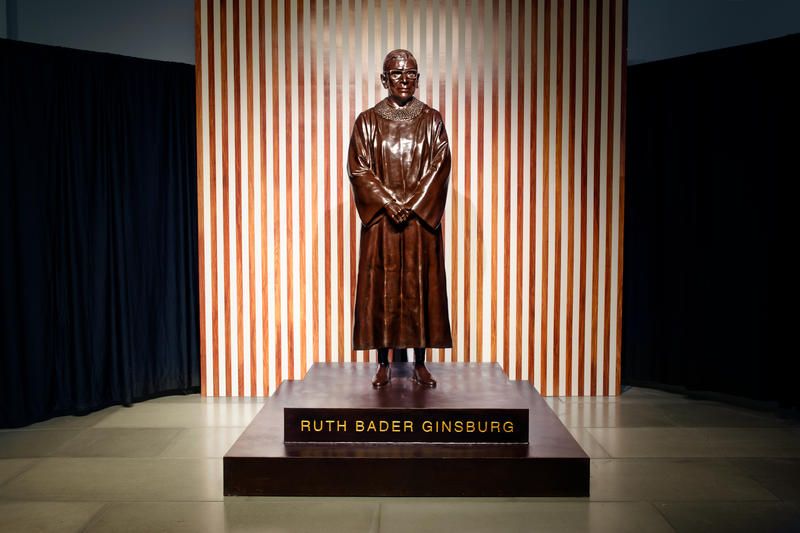
Artist duo Gillie and Marc created this bronze of late U.S. Justice Ruth Bader Ginsburg to commemorate her fight for gender equality and human rights. The statue is one of ten statues of notable women installed in New York City to increase the representation of women in public sculpture from three to ten percent. The statue is on view from noon to 8 p.m. daily in the lobby of City Point in Downtown Brooklyn.
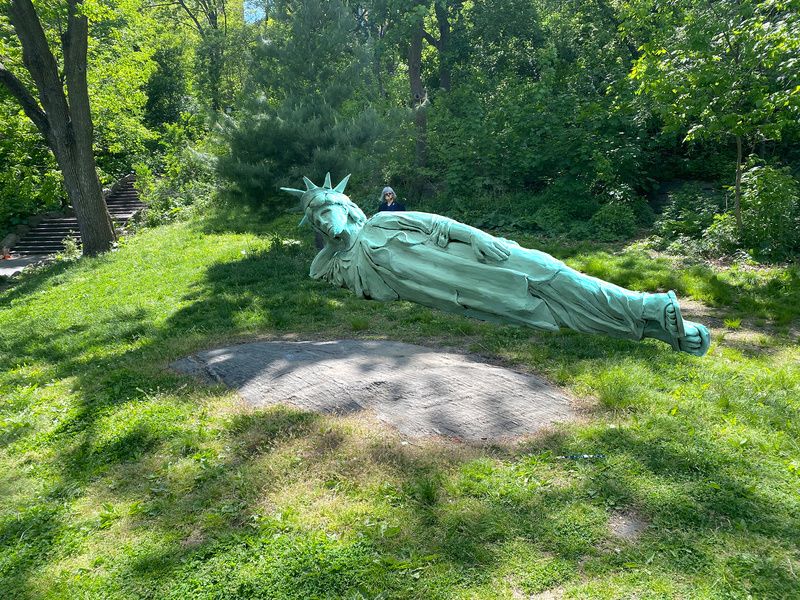
Reclining Liberty by artist Zaq Landsberg is set to premiere, after much delay, in Morningside Park on April 26. The slightly weary-looking Lady Liberty seems to be waiting, like most of us, for better days that surely are coming. The artist, in explaining his draw to monuments, states, “They are literally where the political and the aesthetic meet.”
You can visit the statue at the base of the stairs at 120th Street and Manhattan Avenue in Harlem. Reclining Liberty will remain on view through April 25, 2022.
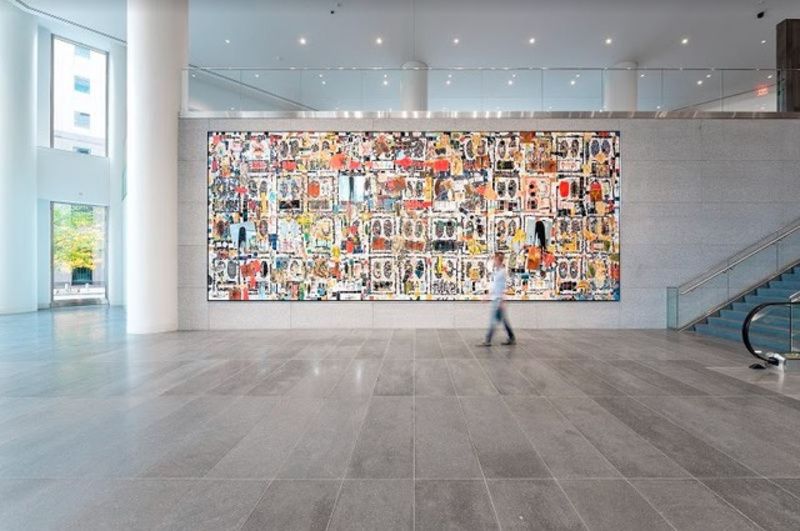
The works of Rashid Johnson employ a wide range of mediums to explore the themes of art history, individual and shared cultural identity, personal narratives, and materiality. His work often includes diverse materials rich with symbolism and personal history.
The mosaic Untitled Broken Crowd is composed of handmade ceramics, wood, brass, oyster shells, spray paint, wax, soap, and mirrors. The soaring piece spans 14 by 33 feet. Located at 200 Liberty Street at Brookfield Place, visitors will be able to contemplate Johnson’s extraordinary piece mounted in the lobby entrance. The glass facade of the building also allows the piece to be highly visible from the surrounding streets.

In July 2021, American contemporary artist Logan Hicks completed Tunnel Vision, the world’s largest stenciled mural. Presented by Taglialatella Galleries, the mural is 19,000 square feet — created with over 100 gallons of paint, 500 cans of spray paint, hundreds of stencils, and dozens of rolls of Gorilla Glue. Located within the East River Plaza on 117th Street in East Harlem, Tunnel Vision includes vivid imagery of lush greenery climbing up the 30-foot walls before merging into the sparkling blue-painted ceiling.
Inspired by Christian Cooper — a Central Park birdwatcher who was victimized in a racially charged confrontation with Amy Cooper in May 2020 — Hicks aimed for Tunnel Vision to recreate the feeling of visiting the Ramble. To accomplish this, dozens of stenciled birds that live within New York State were drawn into the green thicket on the wall. In relation, the mural is accompanied by a custom-designed sound installation featuring a four-hour looping soundtrack, featuring the calls of every bird indigenous to New York. Reflecting on Tunnel Vision, Hicks stated: “This started with a vision of going beyond making just a mural. I wanted to make an environment where people could forget they were in the middle of the city — even if only for a moment.”

For nine months from August 2 to Spring 2022, the Broadway Mall Association will present Jon Isherwood’s Broadway Blooms: Jon Isherwood on Broadway — a series of eight marble sculptures located on the green malls at the center of Broadway from 64th Street to 157th Street. Originally planned for display in 2020, the exhibition’s sculptures were delayed in being transported from Isherwood’s studio in Italy due to the COVID-19 pandemic. Broadway Blooms will mark the Broadway Mall Association’s 13th sculpture show since 2005 as part of their Art on the Malls program.
Each sculpture’s design in Broadway Blooms was inspired by flowers and their diverse cultural meanings — ranging from the imbued spiritual symbolism of the lotus flower to the holiday tradition of poinsettias. Moreover, flowers reflect one’s connection to themselves and their surrounding community; this is reflected in the sculptures’ placements at a series of major intersections along Broadway — which promotes a sense of interconnectedness in spaces that are otherwise impersonal. Carved in Bardiglio Imperiale, Fantastico Arni, and Rosa Portogallo marble, Broadway Blooms offers a beautiful respite from the surrounding urban landscape. At the same time, Broadway Blooms distorts the flowers’ natural appearance, with carved lines contouring the sculptures’ surfaces to create an illusion of expansiveness and promote associations of patterning, layering, and veiled imagery.

As a creative addition underneath the canopy of the required construction shed of Two Manhattan West — Brookfield Properties‘ new 58 story tower set to open in 2023 in Hudson Yards — the company has commissioned Citrovia. Covering over 30,000 square feet of the pedestrian walkway from Moynihan Station to 10th Avenue, Citrovia is a stunning garden consisting of a series of 10-to-20-feet-high lemon trees made from steel and plaster. Attached to the trees are 700 oversized lemons and 3,800 handcrafted leaves made of steel and foam, painted in shades of green and purple. Citrovia is free and open to the public 24 hours a day, 7 days a week. The space is friendly for people of all ages and will even offer interactive augmented reality games for children. Passersby will also have the opportunity to potentially sample citrus-inspired scents. The installation was designed by Cuttlefish, an award-winning team of creative technologists producing experimental work for big-name companies such as Chanel and Apple. Each element of the installation was fabricated by Adirondack Studios, which built Star Wars Galaxy’s Edge at Universal and Diagon Alley at the Wizarding World of Harry Potter.
As Sara Fray, SVP of Marketing for Brookfield Properties stated in a press release, “Citrovia exists for New Yorkers’s pleasure alone. It has no other purpose. We wanted to create a space that’s welcoming and bright to make better use of a space that would otherwise be ugly or inaccessible. It’s not solving the world’s problems, but it’s a delightful midday encounter.”
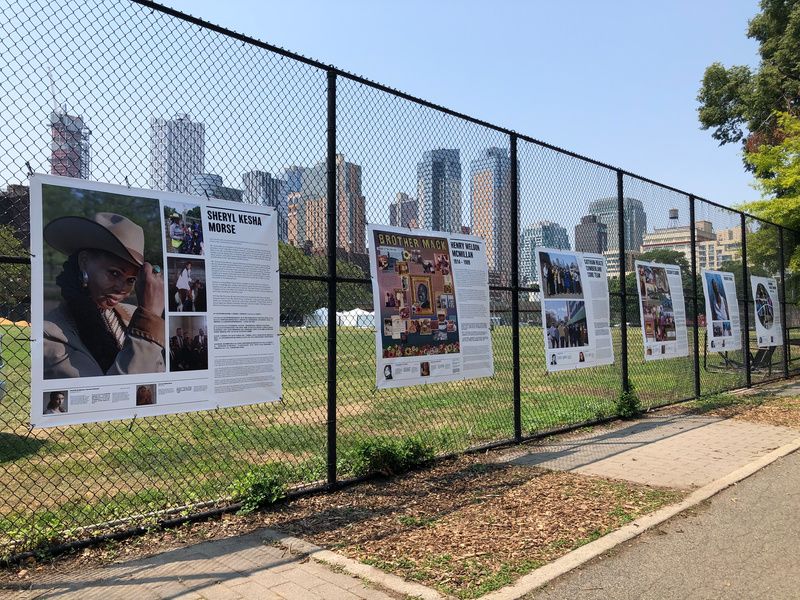
Community Heroes is a community-based public art project celebrating people whose generosity is felt throughout their community. Co-founded in 2016 by Jasmin Chang and Zac Martin in their neighborhoods of Fort Greene and Gowanus, the project aims to highlight the achievements of everyday citizens. Special attention is paid to selecting persons of color from often overlooked communities who have had a faithful and stable long-term presence in their neighborhoods through volunteering, advocacy, mentorship and creativity. Organized and produced by Photoville and Trellis, Community Heroes receives additional support from Partnerships for Parks and PhotoWings. Past projects have included Arts to End Violence, a showcase of young artists committed to anti-violence work, and It’s Happening, a celebration of 50 years of the Arts in the Park program.
To produce their work, Community Heroes partners with communities across NYC to nominate heroes. Afterward, these individuals are paired with local artists to make their portraits and youth writers to interview them. The results of this are then displayed as an art exhibition in a local public space. This summer, Community Heroes will have two projects on display. The first is located at Fort Greene Park along the Brooklyn Hospital fence and in Commodore Barry Park along the football field. One featured hero will be Kesha S. Morse, who became the first female member, officer, and President of the New York City Federation of Black Cowboys. This iteration of Community Heroes will run through June 2022. The second project will be open for view from August 10 to July 2022 in Bed-Stuy at St. Andrews Playground along Herkimer Street and Kingston Avenue.

Through June 30, 2022, Susan Stair’s public art exhibition Ascending the Mountain will be on display at Marcus Garvey Park. Drawing inspiration from the underground network used by trees to communicate and share resources, Stair’s exhibit tells a story of remarkable natural growth. What began as a few trees planted during the early 20th century on a mountain of Manhattan Schist has since grown into a sprawling urban forest — its roots pushing down through the land’s rocky outcropping. Today, the naturally seeded forest provides shade, moisture and oxygen while attracting birds and small animals to the surrounding neighborhoods of Harlem.
Ascending the Mountain was installed in three distinct sections along the staircase leading up to the overlook terraces known as the Acropolis and the Harlem Fire Watchtower. The installation provides visitors with eye-level views of the adjacent forest area so that viewers can more effectively make direct connections between the exhibit and its surrounding natural environment. The first section, Roots n Rocks — located near the base of the stairs on the east side of the mountain — focuses on the roots of the now mature trees and how they have moved underground to gather nutrients and resources. One level up is the second section Growing Powerhouse, which illustrates the trees’ ability to bring gallons of water and minerals up the side of the mountain through their trunks. Just below the upper level of the park is the final section, Tree Canopy, which encourages viewers to connect the artwork with the real-life treetops.

On your visit to Forest Hills this summer, an exciting new artwork to check out is Afro Pick: Remembering & Moving Forward. Surrounded by a beautiful array of Versicolor wildflowers in MacDonald Park, Yvonne Shortt’s larger-than-life afro pick sculpture draws inspiration from the item’s storied history. Originating over 5,500 years ago in Egypt, afro picks were once made from wood or stone and were used to tell narratives of the cultures or tribes carving them. Unrecognizable today from their ancient counterparts, afro picks are now largely fabricated using plastic. Since the 1970s, afro picks have become important symbols of Black power, readily used throughout the ‘Black is Beautiful’ movement. This movement sought to promote an embrace of Black culture and identity, with one crucial element being the adoption of more natural and less Westernized hairstyles. As an ode to this, Afro Pick: Remembering and Moving Forward honors those who have died during the pandemic in Shortt’s community (the artist lost both of her grandmothers). Made from recycled wood, the pick’s handle tells a story of strength and resilience, inscribed with the words: “The Iris versicolor wildflower symbolizes wisdom, faith, and courage. Hopefully, we have gained wisdom through COVID, faith from our community and houses of worship, and the courage to envision a better place for our children.”
Situated at the top of the handle is a bust of a young girl, whose features were drawn from several individuals of different cultural backgrounds living within Shortt’s community. As a symbol of diversity and hope for the future, the girl also serves as a representation of the African American community’s perseverance over time. This is exemplified in her hair texture, which is inspired by African rice braiding, a technique used by enslaved people to prevent hunger during their journeys on the Middle Passage. At the bottom of the statue is a series of metal rods that serve as the teeth of the afro pick, reflecting the move from wooden to metal teeth during the 1950s and 1960s. Six additional afro picks will be installed at Queens College and two at Marymount Manhattan College. In September, three other picks will also be placed at Socrates Sculpture Park as part of Shortt’s Hair Sanctuary sculpture.
Next, check out our upcoming tours to explore more of New York City!
Subscribe to our newsletter